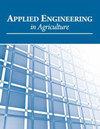Subsurface Drainage for Minimizing the Risk of Subsoil Compaction in Seasonally-Frozen Soils
IF 0.8
4区 农林科学
Q4 AGRICULTURAL ENGINEERING
引用次数: 0
Abstract
HighlightsSubsoil is highly susceptible to compaction based on texture and packing density.Imperfect natural drainage increases the risk of subsoil vulnerability to compaction.Irrespective of drain spacing, the risk for subsoil compaction was high.The upper soil layer protects the subsoil from compaction at drain spacing = 12 m in this soil. Abstract. Subsoil compaction negatively impacts soil hydrological processes and promotes anaerobic conditions, reducing soil productivity and enhancing greenhouse gas emissions from the soil. Additionally, it is challenging and expensive to alleviate subsoil compaction once it occurs. The objective of this study was to assess the effectiveness of subsurface drainage in minimizing the risk of subsoil compaction under different weather patterns in Southern Manitoba. The assessment of the risk of subsoil compaction was done in two stages. That is, 1) determination of the subsoil’s intrinsic susceptibility to compaction based on soil texture and packing density and 2) determination of the wetness condition of the subsoil and ability of the strength of the upper layer of the soil to protect the subsoil. A long-term simulation of soil water content data (i.e., 2000 to 2015) under different drainage spacings (i.e., 8, 10, 12, 15, 25, and 30 m) maintained at 0.9-m depth was obtained to determine the soil wetness condition using a validated HYDRUS 2D/3D model. The study showed that the subsoil’s intrinsic susceptibility level to compaction at the study site was high, implying that the subsoil had a very weak natural potential to resist compaction. Throughout the 16 years considered, the subsoil wetness condition was either “moist” or “wet” irrespective of drain spacing, making the subsoil very vulnerable to compaction. However, for drain spacing = 12 m, the subsoil was found to be protected for most of the spring operation period with minimum impact on the spring operation days based on the criterion that the soil water content in the upper layer should be equal to or less than 90% of the lower plastic limit. In contrast, drain spacing wider than 12 m resulted in a lack of protection of the subsoil for 21 to 50 d. The intrinsic susceptibility of the subsoil to compaction, the “imperfect” internal natural drainage, and excess soil water during the early growing season suggest it is critical to consider the benefits of installing subsurface drains at narrower spacing (= 12 m) because of the ability to improve the soil wetness condition for field operations and prevent short and long-term impacts due to subsoil compaction. Keywords: Bulk density, HYDRUS (2D/3D), Lower plastic limit, Sandy loam, Soil water content.减少季节性冻土地基压实风险的地下排水
底土是高度敏感的压实基于纹理和包装密度。不完善的自然排水系统增加了底土易被压实的风险。无论排水间距如何,底土压实的风险都很高。上层土层保护底土在排水间距= 12 m处不被压实。摘要底土压实对土壤水文过程产生负面影响,促进厌氧条件,降低土壤生产力,增加土壤温室气体排放。此外,一旦发生压实,缓解地基土压实是具有挑战性和昂贵的。本研究的目的是评估地下排水在减少马尼托巴南部不同天气模式下地下土壤压实风险方面的有效性。对地基压实风险的评价分两个阶段进行。即:1)根据土壤质地和堆积密度确定底土对压实的固有敏感性;2)确定底土的湿润状况和上层土的强度对底土的保护能力。利用经过验证的HYDRUS 2D/3D模型,对保持在0.9 m深度的不同排水间距(即8、10、12、15、25和30 m)下的土壤含水量数据(即2000年至2015年)进行了长期模拟,以确定土壤湿度状况。研究表明,研究点地基对压实的固有敏感性水平较高,表明地基抵抗压实的天然潜力非常弱。在整个16年的考虑中,无论排水间距如何,底土的湿度状况要么是“潮湿”,要么是“潮湿”,这使得底土非常容易被压实。而排水间距为12 m时,基于上层土壤含水量等于或小于塑性下限90%的准则,发现底土在大部分春运期受到保护,对春运天数影响最小。相比之下,排水间距大于12米导致21至50天内缺乏对底土的保护。底土对压实的固有敏感性,内部自然排水的“不完善”,在早期生长季节,过量的土壤水分表明,考虑以较窄的间距(= 12米)安装地下排水管的好处是至关重要的,因为它能够改善现场作业的土壤湿度条件,并防止由于地下土壤压实造成的短期和长期影响。关键词:容重,HYDRUS (2D/3D),塑性下限,砂壤土,土壤含水量
本文章由计算机程序翻译,如有差异,请以英文原文为准。
求助全文
约1分钟内获得全文
求助全文
来源期刊

Applied Engineering in Agriculture
农林科学-农业工程
CiteScore
1.80
自引率
11.10%
发文量
69
审稿时长
6 months
期刊介绍:
This peer-reviewed journal publishes applications of engineering and technology research that address agricultural, food, and biological systems problems. Submissions must include results of practical experiences, tests, or trials presented in a manner and style that will allow easy adaptation by others; results of reviews or studies of installations or applications with substantially new or significant information not readily available in other refereed publications; or a description of successful methods of techniques of education, outreach, or technology transfer.
 求助内容:
求助内容: 应助结果提醒方式:
应助结果提醒方式:


